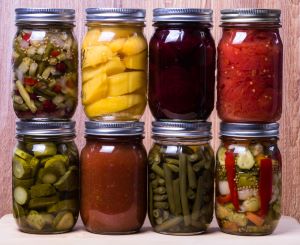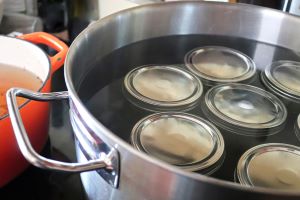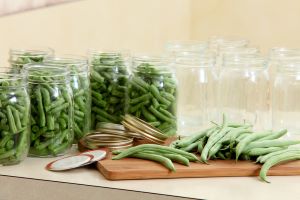Canning
Canning is a method to preserve a wide variety of foods in an airtight container for extended periods of time. This airtight seal, called a hermetic seal, creates an anaerobic or low oxygen environment inside the containers. This low oxygen environment is what prevents bacteria and spoilage. There are two harmful bacteria, Clostridium botulinum , and Listeria monocytogenes, which cause severe foodborne illness that grow in this low oxygen environment. Preventing these bacteria from surviving is critical to the process of producing a safe canned food product. Refer to the Reduced Oxygen Packaging page for more information and to learn more about the hazards and controls.
The canning process varies slightly by product but there are three main steps to include:
- Processing or preparing the food
- Sealing in cans or jars and
- Heating to kill the harmful bacteria and prevent spoilage
 Common foods that are canned include fruits, vegetables, and meats. In a retail establishment an approved Hazard Analysis Critical Control Point (HACCP) Plan and variance is required for canning. Producers can choose to use an approved standard recipe and process or a custom recipe and process that is evaluated by an approved processing authority.
Common foods that are canned include fruits, vegetables, and meats. In a retail establishment an approved Hazard Analysis Critical Control Point (HACCP) Plan and variance is required for canning. Producers can choose to use an approved standard recipe and process or a custom recipe and process that is evaluated by an approved processing authority.
Standard Recipe vs. Custom Recipes
With standard recipes there are still naturally occurring variations in acidity (pH) between and among fruits and vegetables, therefore it’s important to follow an approved standard recipe and process when canning these foods.
Examples of approved standard recipes and processes can be found from:
- Ball® Blue Book™
- USDA Complete Guide to Home Canning
- National Center for Home Food Preservation
- A University Extension Service
A custom recipe can include:
- Personal or family recipe
- Standard recipe with any additions or changes, such as replacing sugar with artificial sweeteners
- Recipe from a blog or website or
- A custom recipe created by the operator
A custom recipe process can only be used if it is approved by a processing authority. A processing authority is a person or organization having expert knowledge of thermal processing requirements for foods in hermetically sealed containers, and who also has access to a testing facility for making such determinations. A process authority will work with the food producer to refine and approve the plan to minimize the risk of the product becoming contaminated. When using an approved standard recipe within a HACCP plan, a process authority is not required.
Documentation required:
- If your HACCP plan is based on an approved standard recipe from one of the resources listed above, no additional scientific documentation is required.
- If your HACCP plan is based on a custom recipe, you must provide additional scientific documentation as required by the processing authority and or regulatory agency. The data must show that your recipe and process provide safe food.
- Each recipe, it's source, and the jar size to be used will need to be submitted with your HACCP plan.
General Components of a Canning HACCP Plan
The HACCP plan for canned foods can vary based on the process, however, the critical control points of a HACCP plan for canning will be similar, and may include:
- Container size
- Particle size/diameter
- Headspace measurement
- Thermal processing
- Seal test or closure testing and
- pH testing
Each of these steps will require documentation and logs to be maintained which is necessary to verify the product is consistently and safely produced. Work with your assigned HACCP consultant who will help you identify all the necessary CCPs to help ensure your process is safe.

